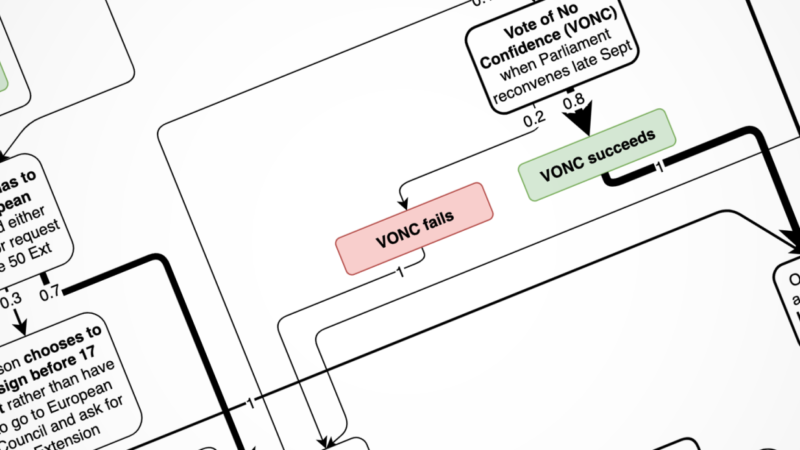The enduring value of #BrexitDiagram – what is important, and what happens in what order

Yesterday pretty much all the Brexit commentators were poring over comments by Jean Claude Juncker that “we can have a deal”, and seeing the chances of a Deal rising. Meanwhile Mujtaba Rahman was trying to interpret Barclay’s words in a speech in Madrid, estimating that the opposite were true due to Barclay’s incendiary language. Earlier in the week everyone was trying to work out whether Johnson flouncing out of the press conference with Bettel was relevant.
My reaction to all of this: one big shrug (well, apart from laughing at Johnson!)
It is all barely relevant.
Why? Because even if there were to be a Deal in Brussels, the chances that Johnson can get it through the House of Commons remain very low – and probably even lower than at May’s Meaningful Vote 3. And that is even if Johnson can get that far – because the outcome of the Supreme Court case about prorogation could even lead to the premature end of his political career.
Or another example. When the idea that Boris Johnson might defy the Benn Act arose a couple of weeks ago, commentators were speculating “Could Johnson actually be brought to court for it?” Again a shrug from my side – because other things (most notably a Vote of No Confidence (VONC)) will almost certainly happen first, Johnson is probably not going to end up in court himself.
Or why did Johnson so determinedly want a 15 October General Election? This was a matter of the chronology of everything – he wanted it before the 17 October European Council, so as to be able to go there and threaten the European Council “give me what I want, or else No Deal”. That also explains why Johnson has gone rather quiet about an early election since the Commons thwarted him, and the fact that they did was also foreseeable because it had an impeccable logic to it.
Looking further back, there was massive fear in February and March that No Deal Brexit was the most likely outcome because it was (and is) the default. None of my diagrams have ever put the odds of No Deal at higher than 25%, something that has often drawn criticism. But there were ways, and still are ways, to stop No Deal – notably because there is a majority of MPs in the current House of Commons that is against No Deal. Trusting the default is not enough.
Those are the sorts of issues that make my interminable series (the first 2 series of diagrams here, the most recent ones here) of diagrams so vital. They help work out what is important and what is not, and also help to explain why actors in the Brexit process are behaving the way they are.
Putting it in other words: the most important function of the diagrams is to work out the paths to each outcome, and to determine what decisions will be important and which ones are not.
The probabilities on the diagrams have also attracted a fair share of critique.
The probabilities are based on how MPs have voted in the past, how the EU has behaved in the past, and what leaders of UK parties have said in public statements. Beyond that I use the views of other trusted commentators to make an educated guess as to the odds – to work out the chances of different outcomes from the Supreme Court there’s a lot of this sort of guessing for example. Also I am always very open to suggestions about these numbers – what is right or not. And I often change the numbers based on suggestions from Twitter. Plus if you get the routes right, you can change odds on nodes and still end up with similar end outcomes – see what happens if prorogation is justiciable or non-justificiable in Diagram Series 3 Version 21 for example.
But even if you don’t like or trust these numbers, the contrary question is this: what else have you got?
You can just pick a number without an open and transparent methodology. Or not try to put odds on anything at all. And – although I admit it is only one data point – my second series of diagrams in the spring had routes to Brexit delay (through extending Article 50) as massively more likely than any other outcome (79% chance on the first diagram with probabilities on the nodes).
Also one final note: so far I have produced over 50 diagrams, and each takes a good couple of hours to make. I have received a sum total of zero payment for all of this. Zero. None. Not a penny. Yes, it would be nice to improve the graphics further. To animate them (although the ace folks at ZN did make a game out of the diagrams!). To provide detailed explanations of my rationale for each node. But those things are sadly all beyond either my reserves of time, or my abilities just now.
I nevertheless hope that all of that notwithstanding, there is still some value to these diagrams!
Jon – your diagrams are an oasis of (at the very least, pseudo) clarity in the farcical chaos of Brexit. I for one look forward to seeing the latest version, and in the main, they give some kind of hope of an eventual coherent resolution. Keep up the good work!